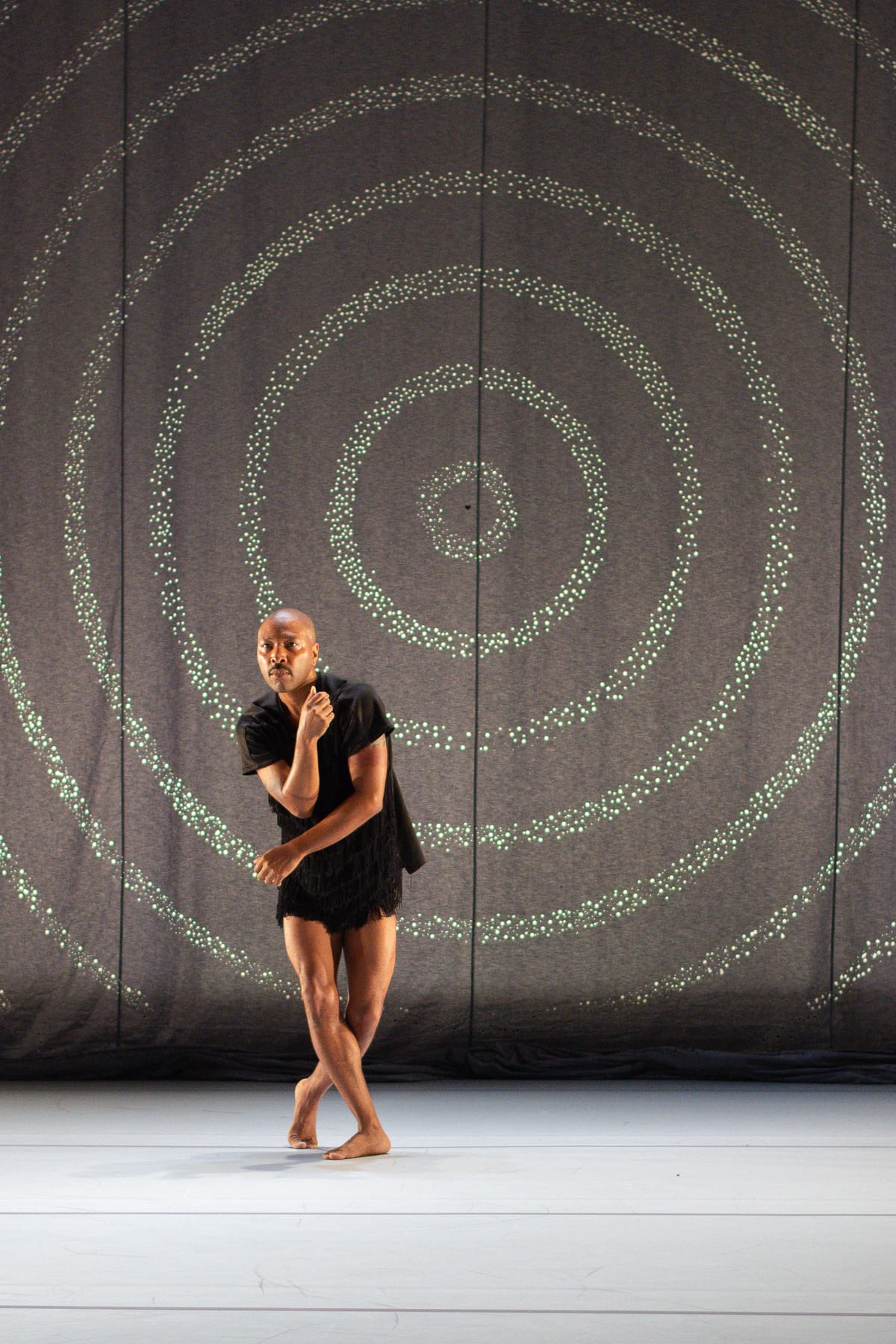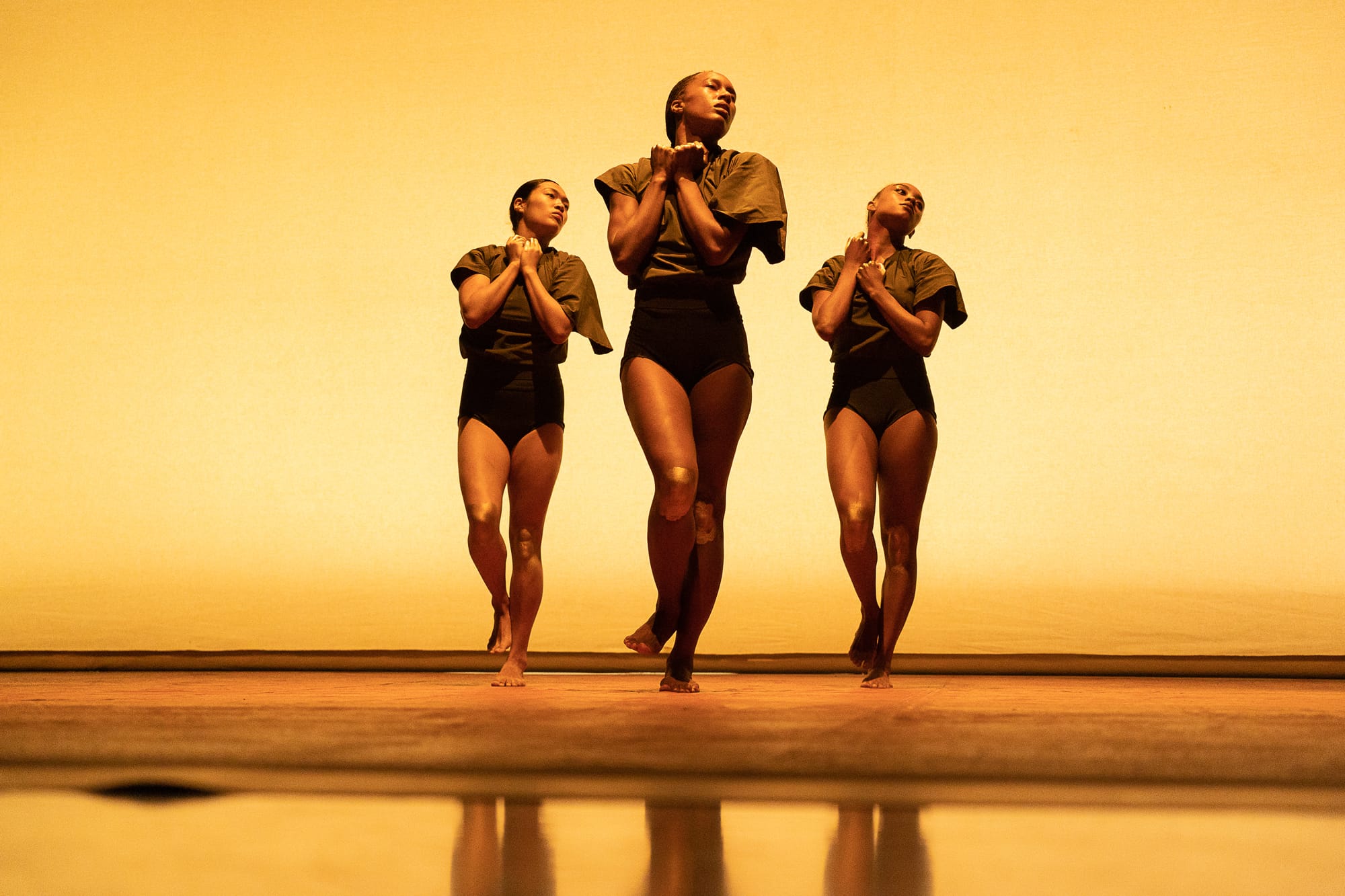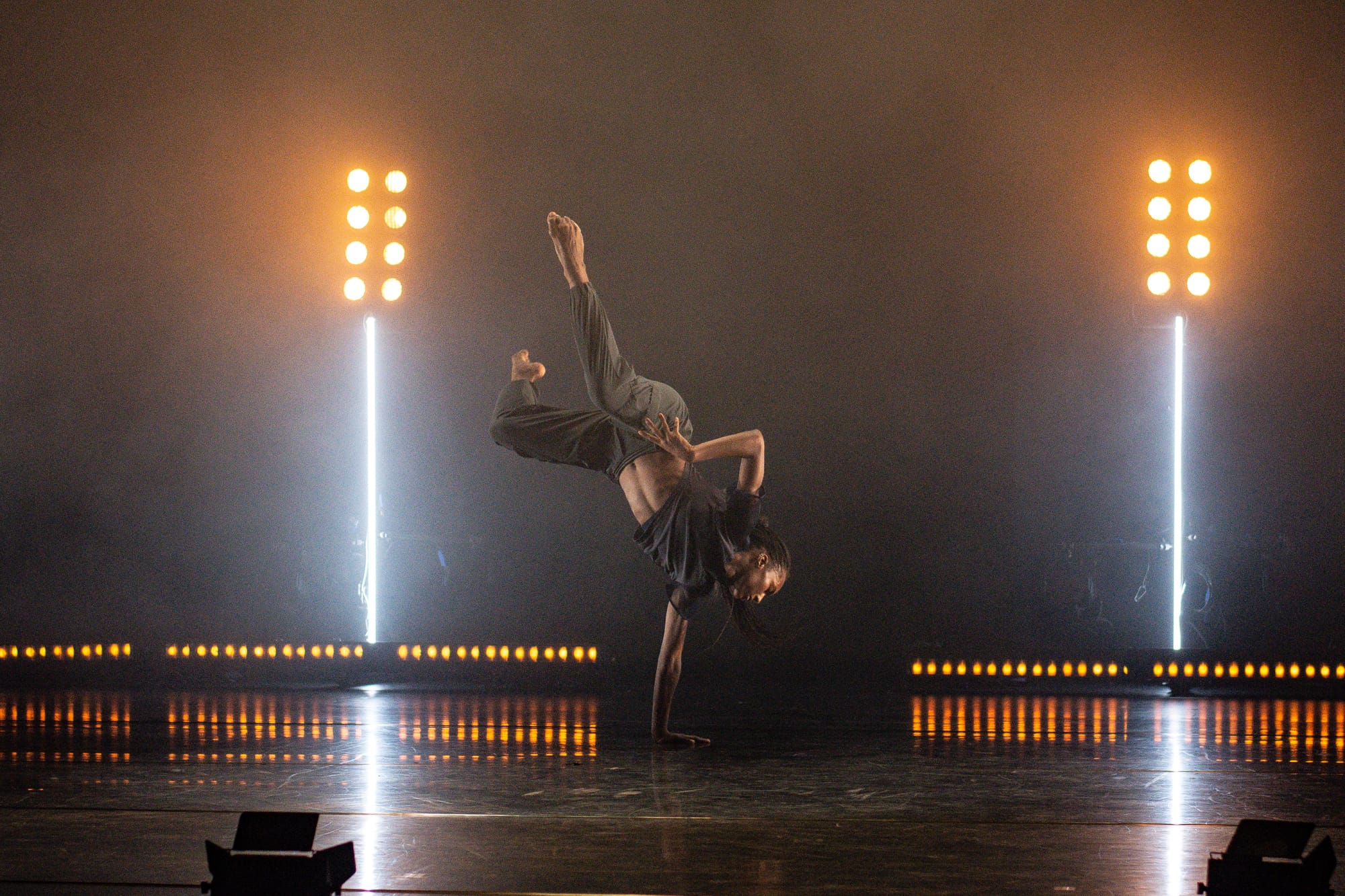Kyle Abraham’s A.I.M. at Jacob’s Pillow

“state,” “INDY,” “The Quiet Dance,” “Show Pony,” “Drive”
A.I.M. by Kyle Abraham
Jacob’s Pillow Dance Festival
Becket, MA
August 1, 2019
Kyle Abraham is everywhere these days, or almost everywhere. He is so busy creating dances for such companies as New York City Ballet and the Paul Taylor Dance Company, he rarely has time to perform with A.I.M., his own group. Jacob’s Pillow audiences are fortunate this week to be able to see Abraham dance a solo with A.I.M (the show runs through Sunday). He created the work, entitled “INDY,” last year for the Joyce Theater in New York. It was the first solo he had made for himself in nearly ten years.
Probably the first thing you notice when Abraham enters the stage in “INDY” is his costume by Karen Young, which is fabulous. It consists of an extravagantly fringed top and trousers, all in black. The fringe plays its own role in the dance, shimmying with the movement. The scenic design by Abigail DeVille and lighting by Nicole Pearce are also important, shifting to create various illusions through the course of the dance, from images of golden curtains to a final silver target.
In “INDY,” Abraham appears to be mining some of the same territory he explored in “Live! The Realest MC,” seen in April at NYU’s Skirball Center. There is a similar emphasis on identity roles expressed through ways of walking — how identity can be created and instantaneously switched even in this simple, everyday activity. Also, how walking as a means of self-presentation can be manipulated to create certain effects, how it can be learned, and practiced until it becomes a second nature, whether it be a flirtatious sashay, a business-like stride, or a young dude’s rolling stroll.
So Identity in all its malleability is once again on Abraham’s mind. So is tension and struggle, which has been the black man’s lot in America since being brought to these shores by force centuries ago. There is a moment in the dance when Abraham repeatedly opens his mouth wide, as if trying to communicate but being unable to do so, as if no one understands what he is trying to say, and the sense of frustration that comes with it. At another point he strips down to his fringed shirt and underwear, as if trying to get at a core of authenticity, something deeper that is truly himself. The work ends in a blackout with no definite answers found. Abraham examines these various themes within the context of a dance vocabulary that melds a variety of genres into a highly personal way of moving and expressing himself.

Abraham is a contemporary dance choreo- grapher who has opened his programs to other artists, something Alvin Ailey did in modern dance many decades ago and is becoming more prevalent today. The repertory approach makes sense, and in this case, Andrea Miller’s “state” provided the surprise of the evening, at least for this viewer. I had not seen her company, Gallim, for several years and in the interim Miller has truly found her own voice. Her early dance grew out of gaga and her work with Ohud Naharin. “state” shows that she has moved into a space that is much more her own. It is a powerful piece for three women, here featuring A.I.M.’s Keerati Jinakunwiphat, Catherine Ellis Kirk and Marcella Lewis. It begins with them nearly in silhouette, moving together in tiny steps against a backdrop of yellow light, like an endless plain or desert. They seem to be looking inward, meditatively as they move side to side, then forward in close synchronization. Their movement gradually expands, gestures reach and grow larger until they are dancing more freely in arcs of movement. But trouble lurks.
The second movement starts with each in a backbend, hands and feet connected to the floor, their bodies looking exposed and vulnerable. By the time the third movement starts, Reggie Wilkins’ sound score has become violent and the women dance out individual traumas. In the last movement, the three return to the kind of small, closely aligned steps of the beginning, now with occasional gestures of support for each other. “state” is subtle and immensely powerful in its sense of women’s lives and oppression. Pain is never expressed in overt terms, but in a kind of movement that distills the essence of a deep, internalized sadness.
Abraham’s “Quiet Dance” from 2011, offers quite a different view of his work from the highly personal “INDY.” The dance, set to Leonard Bernstein”s “Some Other Time” played by Bill Evans, has moments of silence and stillness that account for its title. The piece contrasts a soloist, Kirk, with a group of four dancers: Matthew Baker, Tamisha Guy, Jinakunwiphat and Claude ‘CJ’ Johnson. While the group moves in close synchronization on one side of the stage, Kirk dances movements that echo, mirror, or play with those of the group. The dance is exploratory and introspective on her part, more emphatic on theirs. Kirk seems to occupy her own world, yet she is connected to the others through the dance’s vocabulary. That vocabulary is quintessential Abraham. It includes gestures that are repeated in many of his dances, such as one in which the hands are clasped low, twist up and over shoulders and head, then back down, as the body slides and rocks with the rhythm. Also ubiquitous are the rapid fire hip hop moves, the blunt kicks of martial arts, the occasional surprise of an arabesque, all merged into a disciplined structure that delivers clarity as the movement drives the dance forward. It is the combination of varied movement sources, a rich array of invented gesture, and structural control that makes Abraham’s dance so compelling.

A far more frenetic version of his vocabulary, this time with the addition of acrobatic moves like cartwheels and hand stands, was to be had in the final dance, “Drive.” The work includes a phenomenal lighting design by Dan Scully that started with a band of red lights glittering across the back of the stage, visible through dense fog and darkness, like airport runway lights in bad weather. Within this miasma, a dancer is glimpsed flinging himself into tumbling moves. Soon the fog clears enough to see the entire company of eight (Baker, Guy, Jinakunwiphat, Johnson, Kirk, Lewis, Donovan Reed and Jada Jenai Williams) dancing their hearts out, as the lights shift to diagonals of blue, towers of white, then back to bands of red, the stage now in near darkness, now alight, and as hip hop sound and lyrics blare from hidden speakers. But this is Abraham, so as much as energy is on display, so is control. And the work ends with no sense of frenzy.
There was one more dance on Thursday’s program, a solo that Abraham made for a student and liked enough to transfer to his company. It is called “Show Pony,” an apt title for a student’s presentation, and it is set to a score entitled “Hatshepsut” by composer Jlin. It was danced my Marcella Lewis, who was dressed in a gold body stocking that made her look like a precious statue of Hatshepsut, herself. The dance features a number of robotic moves that even include a robotic smile. So perhaps the reference is not so much to Egyptian queens as to “Star Wars’” C-3PO.
Abraham is undoubtedly the choreographer of the moment, so it is no surprise he can attract a highly gifted group of artists. Still, his dancers have such fluidity and strength, and conduct themselves with such fierce dedication, they are a continual wonder to watch. Those not lucky enough to catch them at Jacob’s Pillow will have another chance to see the company in October at the Joyce.
copyright © 2019 by Gay Morris



